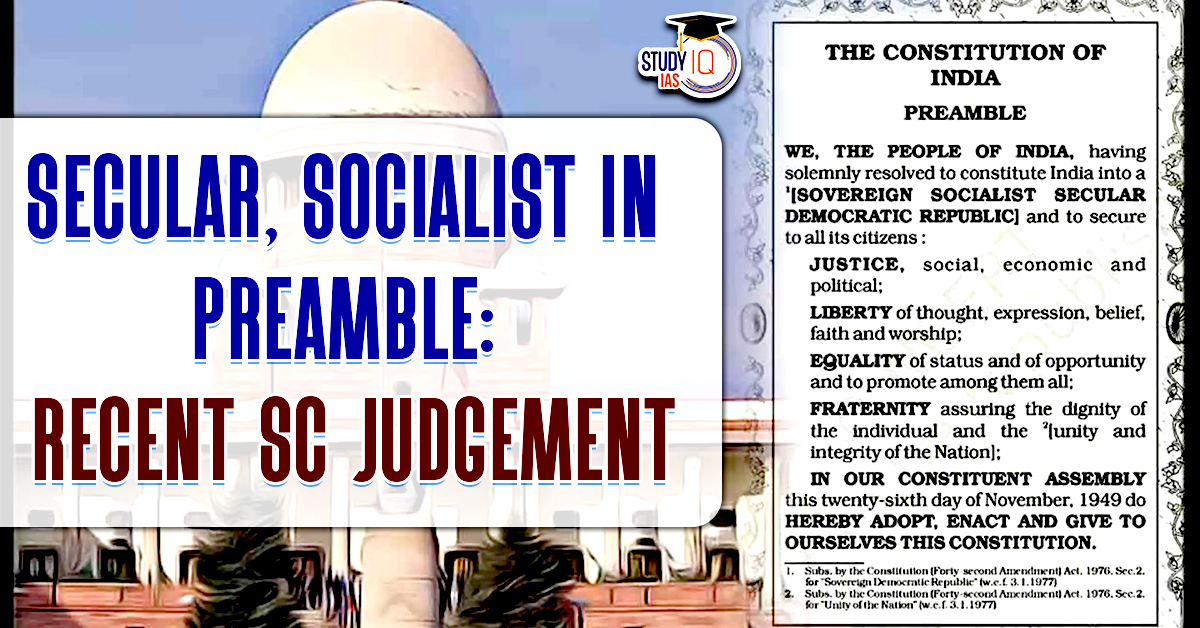Table of Contents
42nd Constitutional Amendment Act, 1976
- Also known as the “Mini-Constitution,” is one of the most comprehensive amendments to the Indian Constitution.
- Enacted during the Emergency (1975-77) under Prime Minister Indira Gandhi.
Key Features and Changes
- Changes to the Preamble:
- Words “Socialist” and “Secular” were added to reflect the commitment to socialism and secularism.
- The phrase “Integrity of the Nation” was included to emphasize national unity.
- Directive Principles of State Policy (DPSPs):
- New DPSPs were added:
- Article 39A: Free legal aid to ensure justice.
- Article 43A: Workers’ participation in management of industries.
- Article 48A: Protection and improvement of the environment.
- DPSPs were made superior to Fundamental Rights to promote socio-economic goals.
- New DPSPs were added:
- Curtailment of Fundamental Rights: Article 31C was amended to give primacy to laws implementing DPSPs over Fundamental Rights, particularly the right to equality and freedom.
- Judiciary: Restricted the power of the judiciary to review constitutional amendments (amended Article 368).
- Limited the scope of judicial review by removing certain laws from judicial scrutiny (via Ninth Schedule).
- Strengthening Central Government: Shifted the balance of power towards the Centre by:
- Requiring state laws to receive presidential assent in certain cases.
- Giving more powers to Parliament over state legislatures.
- Extension of President’s Rule: Extended the duration of President’s Rule in a state from 6 months to 1 year under Article 356.
- Parliamentary and Legislative Tenure: Increased the tenure of Lok Sabha and State Legislative Assemblies from 5 to 6 years (later reversed by the 44th Amendment).
- National Emergency Provisions: Enhanced central powers during an emergency, reducing the scope for state autonomy.
- Tribunals: Introduced provisions for the establishment of administrative and other tribunals under Part XIV-A (Articles 323A and 323B).
- Constitutional Amendments Process: Declared that no constitutional amendment could be challenged in court on any ground, including violation of Fundamental Rights.
- Service Tenure of Civil Servants: Ensured that the President, in consultation with the UPSC, would determine the conditions of service for civil servants.
Controversies and Criticisms
- Excessive Centralization: Critics argued that the amendment undermined the federal structure by reducing the autonomy of states.
- Weakened Judiciary: The amendment limited the judiciary’s independence and powers of review.
- Fundamental Rights vs. DPSPs: The prioritization of DPSPs over Fundamental Rights was viewed as detrimental to individual liberties.
- Emergency Context: Passed during the Emergency, it was seen as a tool to consolidate power and suppress dissent.
Subsequent Revisions
The 44th Amendment Act, 1978 reversed many provisions of the 42nd Amendment:
- Restored the original tenure of Lok Sabha and State Assemblies to 5 years.
- Re-established judicial review powers.
- Limited the scope of Article 31C to only laws under Articles 39(b) and 39(c).
| Procedure to Amend Constitution |
| The procedure of amending the Indian Constitution is laid out in Article 368.
Types of Amendments
|
Supreme Court’s Judgement
- Power of Parliament to Amend the Constitution: The court reaffirmed that Article 368 of the Constitution empowers Parliament to amend the Constitution, including the Preamble.
- It emphasized that Parliament’s authority under Article 368 is unquestionable and unchallenged, provided the amendment does not violate the basic structure doctrine.
- Amendments to the Preamble: The court upheld the incorporation of the terms “socialist”, “secular”, and “integrity” into the Preamble, stating that these additions are consistent with the Constitution’s broader principles and objectives.
- It noted that the Preamble is a living document, and Parliament is empowered to amend it to reflect the evolving needs and aspirations of the people.
- Delay in Filing Petitions: The court criticized the petitioners for the 44-year delay in challenging the amendment.
- It observed that the terms “socialist” and “secular” have been widely accepted and understood by the people of India, and their inclusion has not hindered governance or policymaking.
- Interpretation of ‘Socialist’ and ‘Secular’:
- Secularism: The court highlighted India’s unique interpretation of secularism, where the State maintains neutrality toward religion, does not favor any religion, and ensures individual freedom to practice faith.
- This principle aligns with Articles 14, 15, and 16 of the Constitution.
- Socialism: The court clarified that socialism, in the Indian context, does not imply rigid economic doctrines but reflects the principles of economic and social justice.
- It allows for both private enterprise and state-led welfare measures, ensuring no citizen is disadvantaged due to social or economic circumstances.
- Secularism: The court highlighted India’s unique interpretation of secularism, where the State maintains neutrality toward religion, does not favor any religion, and ensures individual freedom to practice faith.
| The Endurance of Secularism in India’s Constitutional Framework |
|
- Retrospectivity Argument: The court rejected the argument that amendments to the Preamble have retrospective effects, stating that this logic would apply to all constitutional amendments, which is not sustainable.
- No Violation of Basic Structure: The court found no evidence that the inclusion of the terms violated the basic structure doctrine or fundamental rights.
- Practical Impact: The court noted that these amendments have neither restricted nor impeded the functioning of elected governments or their policies, as long as they remain consistent with the Constitution and its fundamental principles.


 List of Military Exercises of India 2024...
List of Military Exercises of India 2024...
 GPS Spoofing and Its Impact in India: A ...
GPS Spoofing and Its Impact in India: A ...
 Amrit Gyaan Kosh Portal: A Comprehensive...
Amrit Gyaan Kosh Portal: A Comprehensive...





















